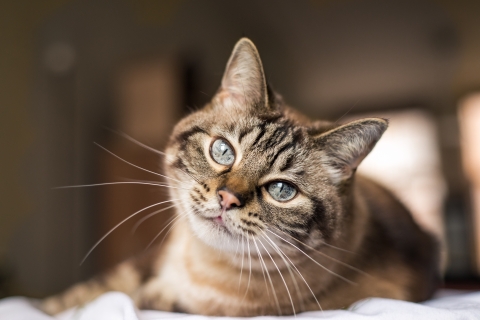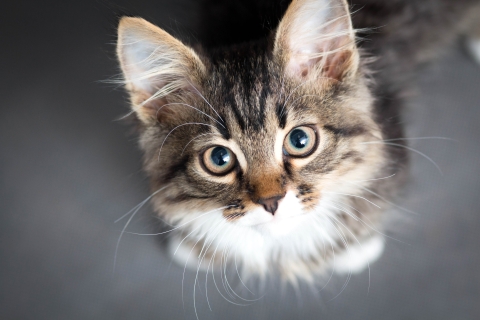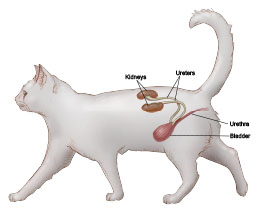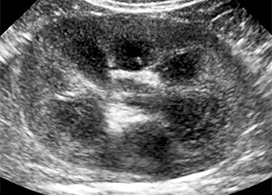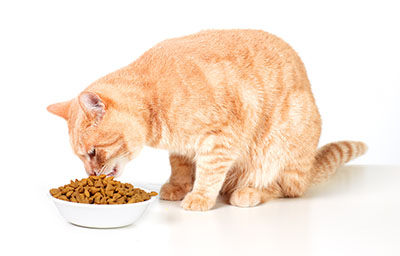Chronic Kidney Disease
Chronic kidney disease, or CKD, is one of the most prevalent diseases in older cats, affecting up to 40% of cats over the age of 10 and 80% of cats over the age of 15. Healthy kidneys perform many functions in the cat, including filtering the blood, making urine, and helping to regulate blood pressure. CKD refers to the persistent loss of kidney function over time and can have many health consequences. The only known risk factor for the development of CKD in cats is age, so it is very important for all senior cats to be regularly monitored for this disease.
Clinical Signs
In the early stages of CKD, it is very common for cats to show no obvious clinical signs, as their body is able to compensate for the decrease in kidney function. As the kidneys lose their ability to concentrate urine effectively, cats may begin to urinate greater volumes and drink more water to compensate. The loss of important proteins and vitamins in their urine may contribute to abnormal metabolism and loss of appetite. Eventually, cats with CKD may experience a buildup of the waste products and other compounds in the bloodstream that are normally removed or regulated by the kidneys. This accumulation may make them feel ill and appear lethargic, unkempt, and lose weight.
Cats with CKD are also at risk for hypertension (high blood pressure) and anemia (low red blood cell count). The kidneys play an important role in maintaining appropriate blood pressure, and this can be disrupted in cats with CKD. Hypertension can lead to sudden changes in vision, neurologic abnormalities such as disorientation and weakness, or heart issues. The kidneys also normally produce a hormone known as erythropoietin, which is vital in the production of new red blood cells. Cats with CKD produce less of this hormone, leading to anemia. Lack of red blood cells will cause cats to feel very lethargic, have a poor appetite, and have pale or white gums.
Diagnosis
To evaluate kidney function, veterinarians will most often turn to blood tests and urine analysis (urinalysis) to evaluate the concentrations of waste products and other components that healthy kidneys normally filter or regulate. It is important to note, however, that there is no single test that can give a veterinarian a complete picture of kidney function and prognosis.
Blood tests can determine the concentration of three important waste products normally filtered by the kidneys: blood urea nitrogen (BUN), creatinine, and symmetric dimethyl arginine (SDMA). Azotemia, or an increase in the concentration of these compounds in your cat’s blood, may suggest that his kidneys are not functioning properly, but these values must be interpreted in light of a number of factors. Creatinine has historically been recognized as the most specific indicator of kidney function, but this test has some limitations. Dehydration, for example, can cause BUN and creatinine concentrations to increase in spite of the fact that a cat’s kidneys are functioning normally. Muscle mass also affects creatinine concentrations, so a very thin cat may have normal blood creatinine levels despite decreased kidney function. SDMA concentrations are less affected by dehydration and muscle mass and also rise earlier in the progression of CKD. Creatinine concentrations in the blood do not generally rise until a cat has lost almost 75% of their renal function, while SDMA elevations are detectable when about 40% of kidney function is lost, potentially allowing CKD to be diagnosed sooner.
In a urinalysis, your veterinarian will consider the concentration of the urine (urine specific gravity, or USG), its pH, and the presence of blood cells, bacteria, and other cells that generally should not be found in feline urine, all of which provide important information regarding the health of a cat’s kidneys. A low urine specific gravity, indicating poorly concentrated urine, can be one of the earliest indicators of CKD in the cat, but this will be falsely decreased in a cat who recently received fluids. Urine protein/creatinine ratio, or UPC ratio, tests for protein loss through the kidneys and can be very important in determining the severity of disease. It is also important to culture a urine sample to rule out the possibility of bacterial infection of the urinary tract in suspected cases of CKD. Urine samples may be obtained either by collection from a litter box filled with non-absorbent beads designed for this purpose, by catheterization of the urethra (the opening of the urinary tract to the outside world), or by cystocentesis, a technique that extracts a urine sample by passing a very fine needle through the abdominal wall into the bladder. Cystocentesis is generally considered a safe procedure, and in most cases will provide the most diagnostically useful sample for analysis.
Ideally, a veterinarian will base their interpretation of kidney function on at least two blood and urine samples, obtained within two weeks of one another, from a stable, well-hydrated cat. The concentrations of other blood components, including various electrolytes (like sodium and potassium), phosphorus, red blood cells, and proteins are also important to evaluate in a cat being examined for CKD. Other studies that can be useful in evaluating a cat with suspected CKD include imaging studies such as abdominal ultrasound, radiographs (X-rays), and, in some cases, microscopic evaluation of biopsy samples. Approximately 60% of cats with CKD will also develop hypertension, so measurement of a cat’s blood pressure is an important part of the medical evaluation for this disease.
The International Renal Interest Society, or IRIS, has developed a staging system to categorize cats with CKD based on these testing parameters. It is important that the staging occurs when the cat is well hydrated and stable, as elevated values in a dehydrated or sick cat could make it appear that they are experiencing a higher stage of disease than they truly are. With this in mind, appropriate staging can provide useful treatment and management strategies for owners and veterinarians, as well as prognostic information based on the severity of disease. Additional substage categories are considered as well, based on the presence or absence of protein in the urine and high blood pressure.
Find out more about the IRIS staging system.
Treatment and Management
Unfortunately, CKD is a progressive disease with no definitive cure, so the goal of treatment is to slow its progression and maintain a good quality of life for the cat. Therapy is geared toward minimizing the buildup of toxic waste products in the bloodstream, maintaining adequate hydration, addressing disturbances in electrolyte concentration, supporting appropriate nutrition, controlling blood pressure, and slowing the progression of kidney disease.
Dietary modification is an important and proven aspect of CKD treatment, and generally the first change recommended early in the course of disease. Studies suggest that therapeutic diets that are restricted in protein, phosphorus and sodium content and high in water-soluble vitamins, fiber, and antioxidant concentrations may prolong life and improve quality of life in cats with CKD. Some studies show that cats with CKD eating a prescription kidney diet live 2-3 times longer than those eating a standard commercial cat food. However, many cats have difficulty accepting therapeutic diets, so owners must be patient and dedicated to sticking to the plan. It is important to make a gradual transition to a therapeutic diet and to consider food temperature, texture, and flavor. Prescription diets for cats with kidney disease come in a variety of flavors and textures and are available in both wet and dry formulations, so it is important to work closely with your veterinarian to find the best option for your cat. Cats with CKD that go without food for relatively short periods of time may develop significant health problems, so it is crucial to make sure that your cat is eating during a transition to a therapeutic diet.
Maintaining good hydration is essential for cats with CKD, as dehydration can speed up damage to the kidneys and cause clinical signs to worsen. At home, this can be encouraged by feeding wet forms of the therapeutic diet and ensuring access to multiple clean water sources. Many cats prefer to drink from water fountains, and having clean bowls with fresh water in several locations in the home will encourage cats to drink more. In some cases, administering fluids under the skin may be necessary to adequately hydrate cats with CKD, especially those with advanced stages of disease. Many owners can learn to perform this at home every 1-3 days with guidance from their veterinarian. During times of illness, intravenous fluids administered in a veterinary clinic may be necessary to maintain hydration until a cat can be stabilized.
Managing related conditions, such as hypertension, anemia and urinary protein loss, can be vital in slowing progression of CKD and improving quality of life. Hypertension and urinary protein loss are generally treated with oral medications, including an angiotensin II receptor blocker known as telmisartan, available in a liquid form FDA approved for controlling blood pressure in cats. Anemia in a cat with CKD was historically treated by replacement therapy with erythropoietin (or the related compound darbepoetin), which stimulates red blood cell production. Cats with CKD may produce less erythropoietin, and there is some evidence that replacement therapy can increase red blood cell counts. This replacement therapy is administered by injection in the veterinary office, but an oral medication (molidustat) is now available to help stimulate red blood cell production in cats with CKD, as long as their blood pressure is also adequately controlled.
A number of other therapies, including phosphate binders, potassium supplementation, antioxidant supplementation, alkalinization therapy, appetite stimulants, and anti-nausea medications, have the potential to help certain cats with CKD and may help improve quality of life for cats living with this disease. These approaches have not all been fully validated, and controlled studies are needed to determine which therapies offer substantial benefits. The same is true of hemodialysis (the removal of toxic waste products from the bloodstream by specially designed equipment) and kidney transplantation. These controversial, complex, and expensive treatments offer potential benefits to cats with CKD, but they have not been subjected to studies to prove their effectiveness, so they should be explored with the careful guidance of a veterinary specialist.
Prognosis
Prognosis for cats with CKD is quite variable and can depend significantly on their response to treatment and the stage of disease at the time of diagnosis. There is evidence suggesting that the earlier CKD is diagnosed and treatment initiated, the better the outcome with respect to quality of life and survival. Cats who are diagnosed with IRIS Stage 2 CKD have a mean survival time of two to three years in many studies, while those who are diagnosed at IRIS Stage 4 on average survive less than 6 months. These are, of course, averages, and regular monitoring is important to determine how quickly an individual cat’s disease will progress. Some studies suggest that cats who lose more protein in their urine, have higher phosphorus levels in the blood, and lower red blood cell counts have a less favorable prognosis.
Chronic kidney disease is, unfortunately, a common problem in older cats. Cats will often show no obvious clinical signs in the early stages of CKD, but early diagnosis gives the best chance for a longer and healthier life. This underscores the importance of regular veterinary exams and monitoring bloodwork for all senior and geriatric cats.
Updated Jan. 2025





